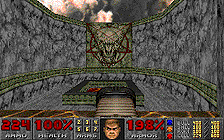Life after Doom

 It's hard to imagine life before Doom, the computer game that did for office productivity what George Best did for sobriety. What comes next? We gave PJ Fisher a shotgun, a few rounds of ammo and a medikit and sent him to find out. He never came back, but this is his report.
It's hard to imagine life before Doom, the computer game that did for office productivity what George Best did for sobriety. What comes next? We gave PJ Fisher a shotgun, a few rounds of ammo and a medikit and sent him to find out. He never came back, but this is his report.
 Doom started on the Internet at a time when most people hadn't
even heard of the Internet. Word of mouth and newsgroup activity
turned it into a phenomenon. You couldn't go anywhere without
finding some sad soul blasting away at horribly pixellated monsters
through that now infamous labyrinth of tunnels and rooms. Hours
later, when they should have been at home, they'd still be there.
Stuck. Desperately trying to get to the next level and then call
it a day.
Doom started on the Internet at a time when most people hadn't
even heard of the Internet. Word of mouth and newsgroup activity
turned it into a phenomenon. You couldn't go anywhere without
finding some sad soul blasting away at horribly pixellated monsters
through that now infamous labyrinth of tunnels and rooms. Hours
later, when they should have been at home, they'd still be there.
Stuck. Desperately trying to get to the next level and then call
it a day.
Doom was not sophisticated. This was no slow moving Myst http://www.cyan.com/ designed to make you think or a platform game designed to entertain. Doom appealed to the basest of human instincts: kill or be killed. The 3D interface is now classic. A pump action canon points into the screen as if you were carrying it, ahead lies the tunnels and rooms. And your "face" appeared in a box, constantly roving its eyes and comically raising its eyebrows. Every now and again you reloaded. That's all there was to it.
 But Doom caught on because it was fast. And the better PC you
had the faster it went. All you had to do was keep up and blow
away whatever came in your path. All over the world computer users
took on a new psyche in front of their screens while the keyboard
took a hammering. Watch anyone playing Doom, or its imitators,
can be quite disturbing as they unleash a series of jerks, facial
ticks and sheer aggression. Virtual Reality seems an unwise option.
If this is what 256 colours and a keyboard can do, what the hell
would it be like if they felt it was real?
But Doom caught on because it was fast. And the better PC you
had the faster it went. All you had to do was keep up and blow
away whatever came in your path. All over the world computer users
took on a new psyche in front of their screens while the keyboard
took a hammering. Watch anyone playing Doom, or its imitators,
can be quite disturbing as they unleash a series of jerks, facial
ticks and sheer aggression. Virtual Reality seems an unwise option.
If this is what 256 colours and a keyboard can do, what the hell
would it be like if they felt it was real?
Its creators, i.d. software http://www.idsoftware.com, gave away the first two levels free on the Internet and then made you buy subsequent levels. Of course most were hooked, after the exhilaration of those two levels they simply had to have more. ID became a fully fledged company and today Doom and its successors can be bought on CD-Rom in the Virgin Megastore.
But Doom had another ace up its sleeve; you could network it. The enemy was no longer the computer but real people across the office, building or the Internet. Now you could blast away with the satisfaction of knowing your enemy was real.
ID kept the Doom momentum going with the release of Doom II. Same idea, just harder with different levels. But no more was asked of the player other than to keep killing. Thinking was still off the menu. Just shoot. In an age that promised (and some actually developed) state-of-art games involving full motion video and interactivity the world got off on a simplistic, nihilistic shoot-em-up. A PC on every desktop? That's right Bill and every one equipped with Doom. Never underestimate the public's taste.
Which is probably the weirdest part of the Doom phenomenon. Pentium PCs equipped with the latest graphics and sound cards were being used to play a game that made little use of them. Surely PC gaming could mean more than Doom? Yet the people who played it were for the most part intelligent, often creative individuals. Why didn't they ask for more? Well they did. And they got Marathon http://www.bungie.com (Doom for Mac users), Hexen http://krypton.mankato.msus.edu/~magic/web/hexen.html, The Hive http://www.microsoft.com/windows/games/samplerad/hive.htm, Descent and now Quake <anchor>. All different, all the same.
So now the Internet is full of individuals hogging bandwidth shooting each other from across the world. Their keyboard skills (the five keys they need) are fantastic and their scores phenomenal. It will take another Doom-style phenomenon to alter the course of computer games. For now all people want is better versions of Doom. That's the future. There is nothing else in sight. No light at the end of the tunnel.






